Searching for Google Workspace alternatives? You’ve come to the right place.
Google Workspace (formerly G Suite) has become a go-to for many businesses seeking communication, collaboration, and document management tools. However, it only meets the needs of some teams. Just because it was made by Google doesn’t mean it's the best software available.
In this guide, we’ll explore the top solutions, including free and cheap alternatives to Google Workspace, so you can find the best fit for your business.
Why you should consider Google Workspace alternatives
While Google Workspace offers seamless collaboration tools, it has limitations:
Limited offline functionality
Google Workspace relies on an internet connection for most of its features. While some apps offer offline access, it’s limited, especially when it comes to real-time document editing and syncing across devices. This can be a challenge for teams that need reliable offline access to stay productive.Limited customization and integration
While Google Workspace is packed with features, it offers limited options for customization and integration with other software. For teams that need to tailor the platform to their specific workflows or connect with other tools, Google Workspace might not be as flexible as other solutions.Cost
The pricing for Google Workspace can become expensive, especially for larger teams. Small businesses or startups might only need a few of its features, but they still have to pay for the full package. There are cheaper alternatives that offer the same features at a lower cost.
What to look for in Google Workspace alternatives
1. Functionality
The alternative should provide the necessary features for productivity. This includes word processing, spreadsheets, presentations, and email management, with a strong emphasis on team collaboration.
2. Collaboration and communication
Effective communication and collaboration tools such as chat, video calls, and file sharing are essential for maintaining team efficiency. Look for tools that streamline these processes.
3. Flexibility
Customization options that allow you to adjust settings, templates, and integrations to fit your team's specific needs can significantly enhance workflow.
4. Integration
Seamless integrations with other software, such as CRM systems, project management tools, or marketing platforms, are necessary for team efficiency.
5. Cost
While some businesses can afford premium solutions, many seek affordable options. Ensure that the alternative offers a good balance between functionality and cost.
6. User interface and team adaptability
A user-friendly interface that is easy for team members to navigate ensures that your team adapts to the new tools with minimal resistance and training.
Google Workspace alternatives at a glance
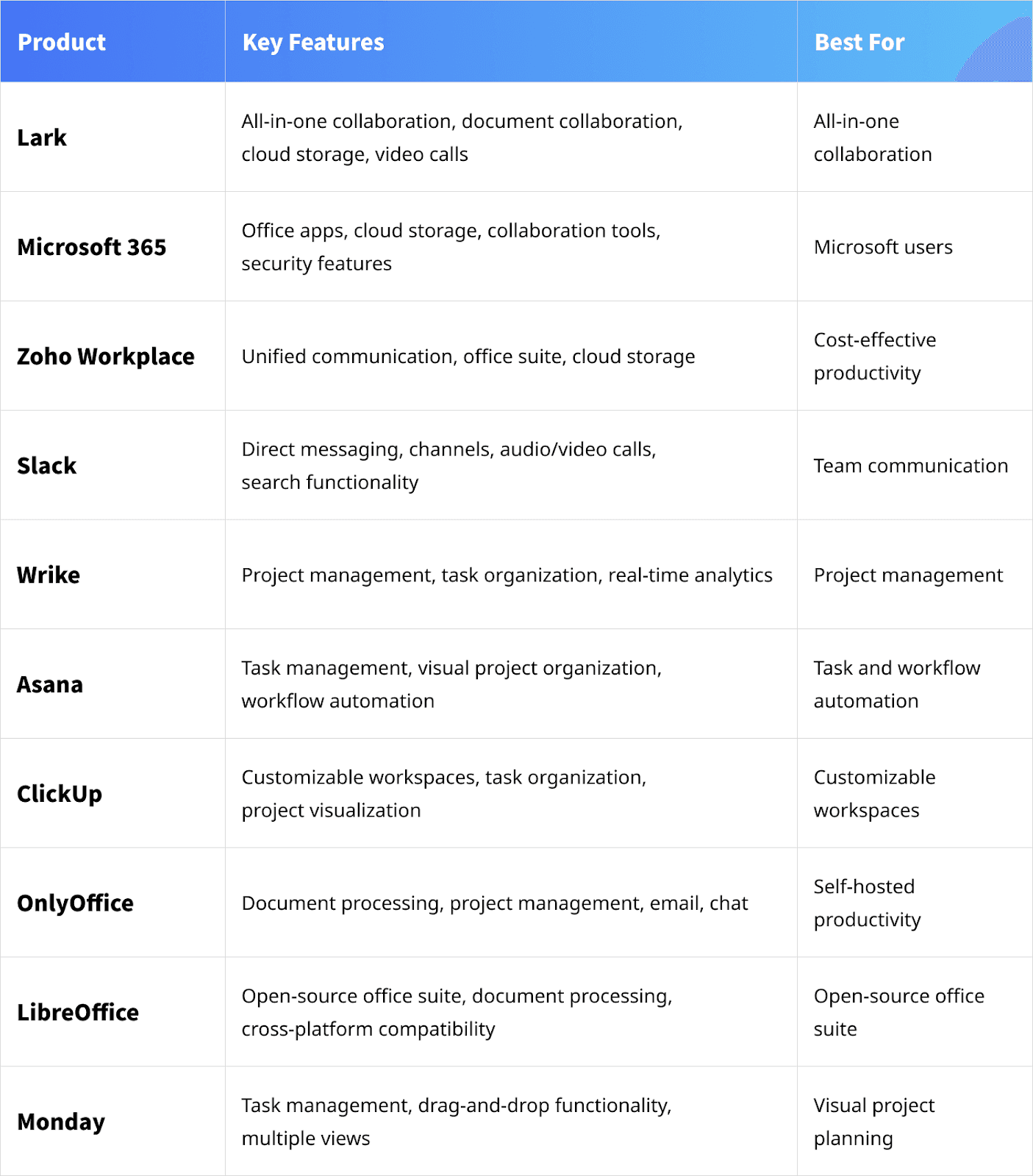
10 best Google Workspace alternatives for 2025
Lark - Best overall Google Workspace alternative
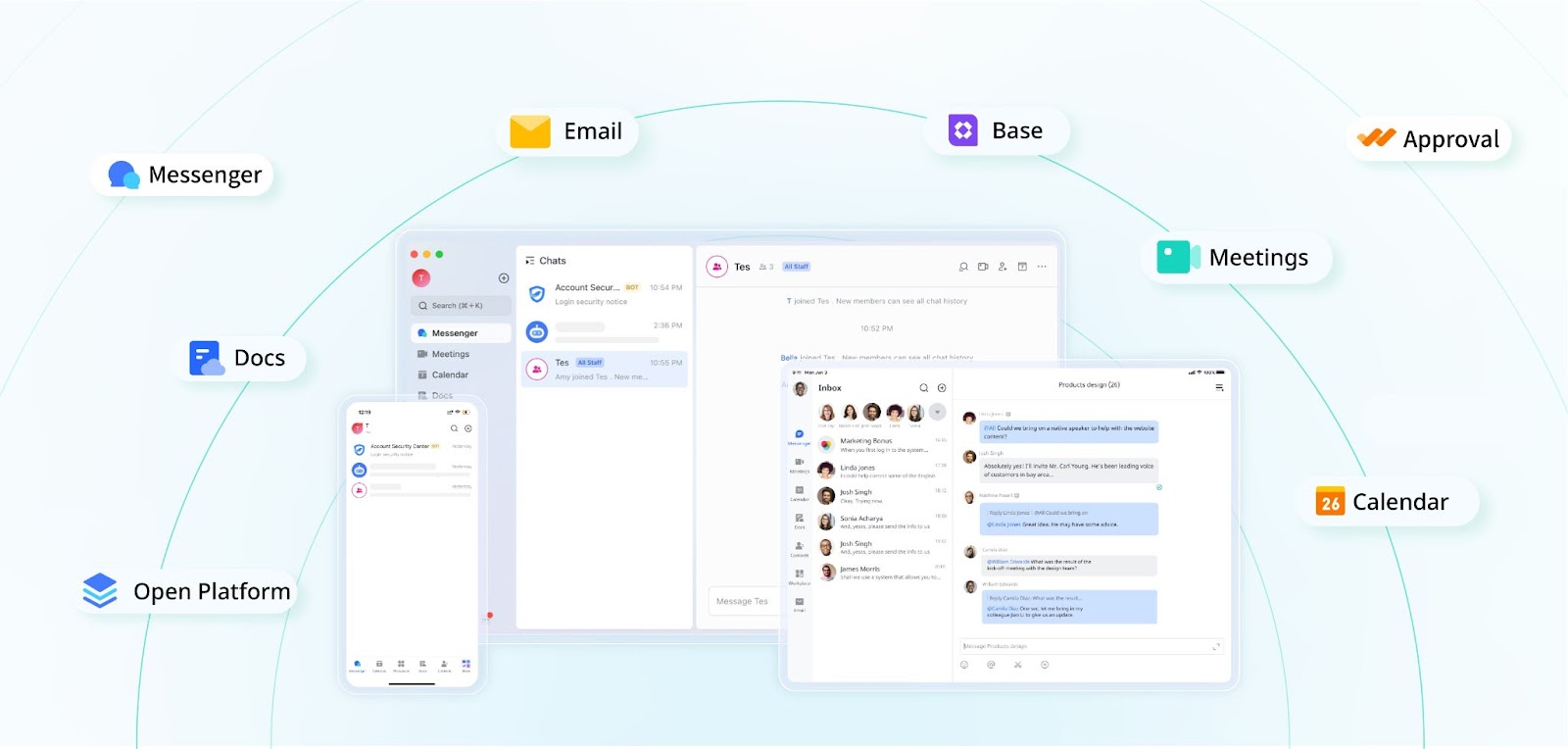
Lark is an all-in-one collaboration platform that integrates communication, document creation, cloud storage, and video calls. This makes it ideal for businesses looking for something similar to Google Workspace.
Key features of Lark:
Communication tools: Instant messaging, tagging, group chats, and more in Lark Messenger.
Document collaboration: Real-time editing, cloud storage, and diagram creation in Lark Docs.
Advanced data management: Designed to streamline project management, Lark Base helps your team get work done. It offers built-in formulas, charts, automation, and more, making data analysis easier.
Collaborative meetings: Video meetings with up to 500 participants with screen sharing, virtual backgrounds, and transcription in Lark Meetings.
Free business email with migration support, high send limits, and offline reading capabilities.
Data security and compliance: Protect customer data with advanced encryption, strict access protocols, and adherence to global regulatory standards.
Cloud storage: Options from 100GB to 15TB + 30GB for each user.
Other features of Lark:
Centralized workspace: Organized channels for easy collaboration, communication, and information flow.
Project management and tracking: Plan, organize, and monitor project progress with tools like Lark Meegle and Lark Base for seamless task coordination.
Workflow automation: Simplify approval processes with Lark Approval, enabling faster decision-making.
Customizable notifications: Alerts tailored to important updates without excess information.
Cross-platform support: Seamless collaboration across desktop, mobile, and web.
Pros:
Comprehensive tools for communication, collaboration, and task management.
Real-time document editing increases productivity.
Advanced tools to simplify scheduling and task management.
Secure cloud storage with end-to-end encryption.
Free plan includes over 11 products making it the best free alternative to Google Workspace.
Cons:
Lark has the widest variety of advanced features. However, you may need to visit Lark's YouTube channel and the Lark Help Center to master all the features.
Integrations:
Lark integrates with other platforms and has a collection of integration options in the Lark App Directory.
Rating:
4.5/5 on G2
Microsoft 365 - Best alternative for Microsoft users
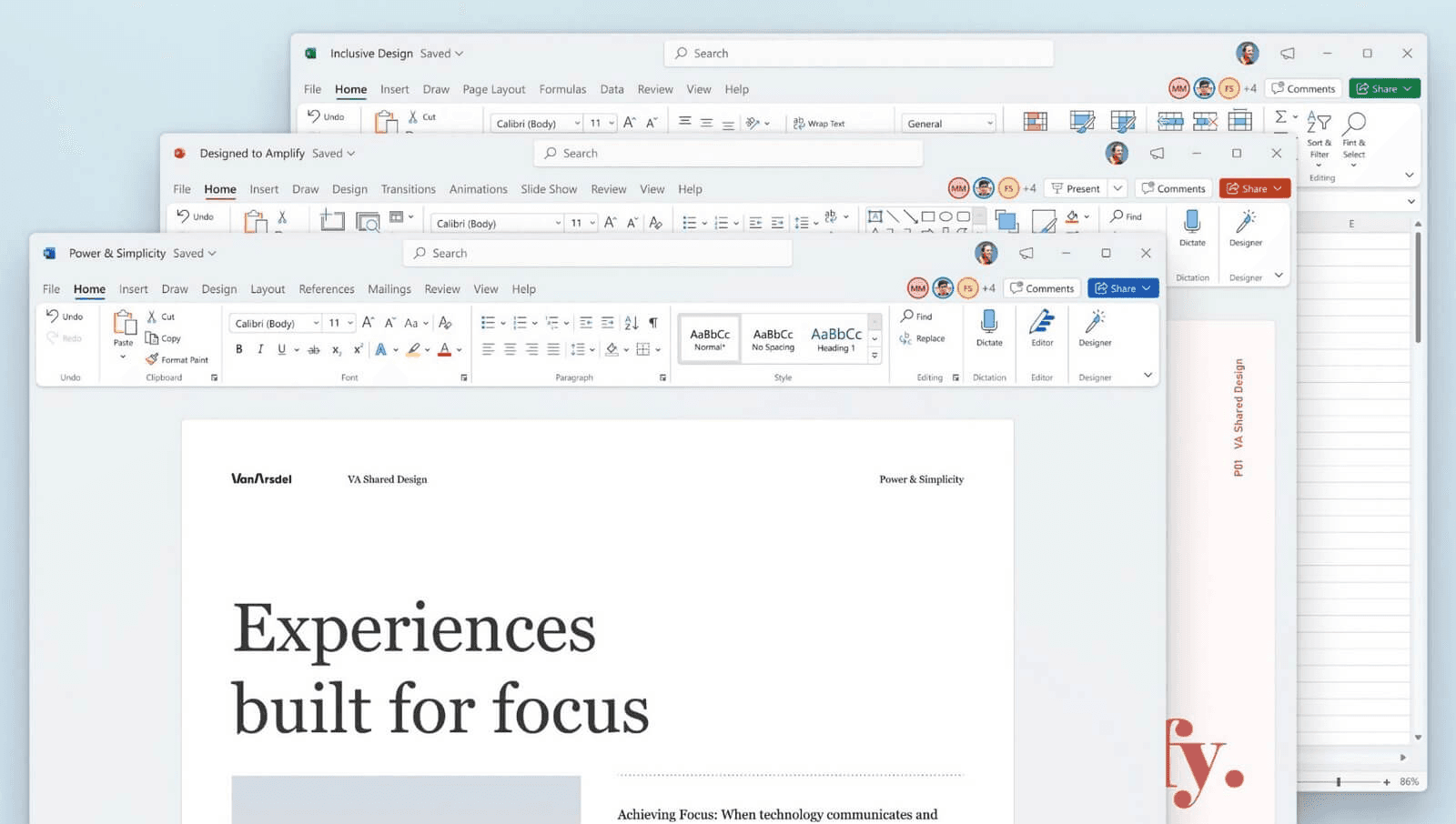
Image source: pureinfotech.com
Microsoft 365 is a subscription-based productivity platform that combines essential tools like Word, PowerPoint, and Outlook. As a complete solution, Microsoft 365 stands out as one of the top suite alternatives to Google.
Key features of Microsoft 365:
Productivity apps: These include Word, Excel, PowerPoint, Teams, and Outlook.
Cross-device compatibility: Install on PCs, Macs, tablets, and phones.
Cloud storage: Offers 1TB of OneDrive storage.
Collaboration tools: Real-time editing, Microsoft Teams integration, and shared document access.
Security features: Includes encrypted email, Data Loss Prevention, and Mobile Device Management.
Pros:
Continuously updated with the latest features and security patches.
Flexible collaboration with real-time document editing and cloud storage.
Scalable subscription plans with pay-as-you-need flexibility.
Accessibility from anywhere with internet access boosts productivity.
Microsoft 365 is the best alternative to Google Workspace for teams that regularly use Microsoft products due to its seamless integration.
Cons:
Ongoing subscription fees can be expensive over time.
Frequent updates may disrupt workflows for users who adapt slowly.
Compatibility issues with in-house bespoke systems.
Most users utilize only a fraction of its functionality.
Integrations:
Microsoft 365 supports many integrations, including Salesforce, Microsoft Dynamics CRM, HubSpot, Slack, Microsoft Teams, Zendesk, OpenAI, NetSuite, and DocuSign.
Rating:
4.6/5 on G2
Zoho Workplace - Best for cost-effective productivity
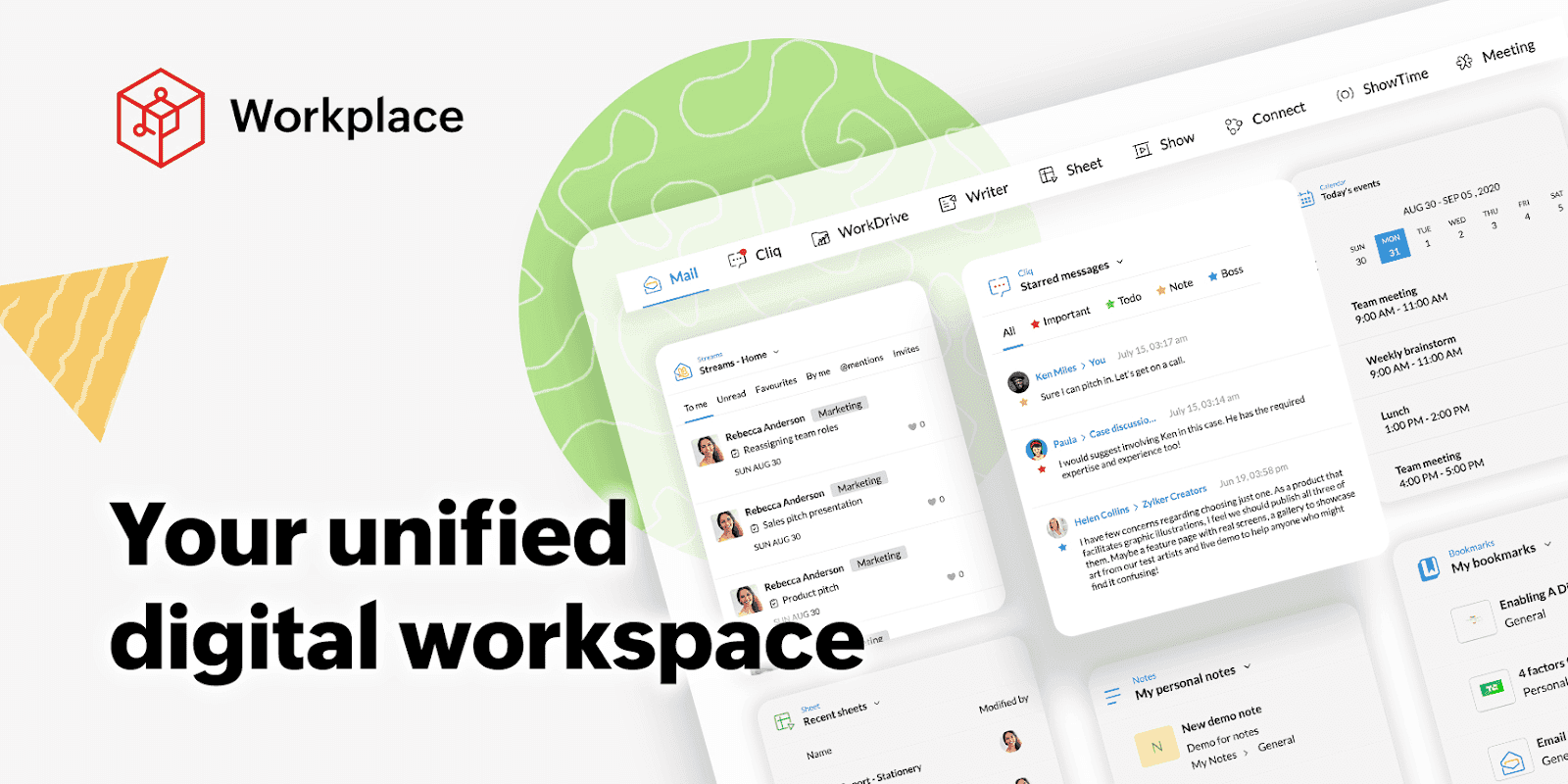
Image source: zoho.com
Zoho Workplace is a platform designed to streamline team communication and collaboration. It combines email, messaging, video conferencing, and more, enabling seamless team collaboration.
Key features of Zoho Workplace:
Unified communication: Email, messaging, and video conferencing integrated into one platform.
Office suite: Tools for document creation, spreadsheets, and presentations.
Mobile apps: Access your workspace on the go.
Cloud storage: Centralized storage for easy file sharing and collaboration.
Security and privacy: Strong measures to protect data and ensure compliance.
Pros:
Combines communication and productivity tools in one place.
Supports integrations with Zoho Apps, Microsoft Apps, and Google Apps.
Affordable and scalable for businesses of all sizes. This makes Zoho Workplace one of the best cheap alternatives to Google Workspace.
User-friendly interface for team collaboration and remote work.
Cons:
Limited advanced features compared to some competitors.
Integration with third-party apps can require manual setup.
Learning curve for new users unfamiliar with Zoho’s ecosystem.
Customer support response times can vary.
Integrations:
Zoho Workplace integrates with various platforms, including Zoho Apps, Microsoft Apps, Google Apps, CRM tools, cloud storage platforms, digital signature and identity providers.
Rating:
4.5/5 on G2
Slack - Best for team communication
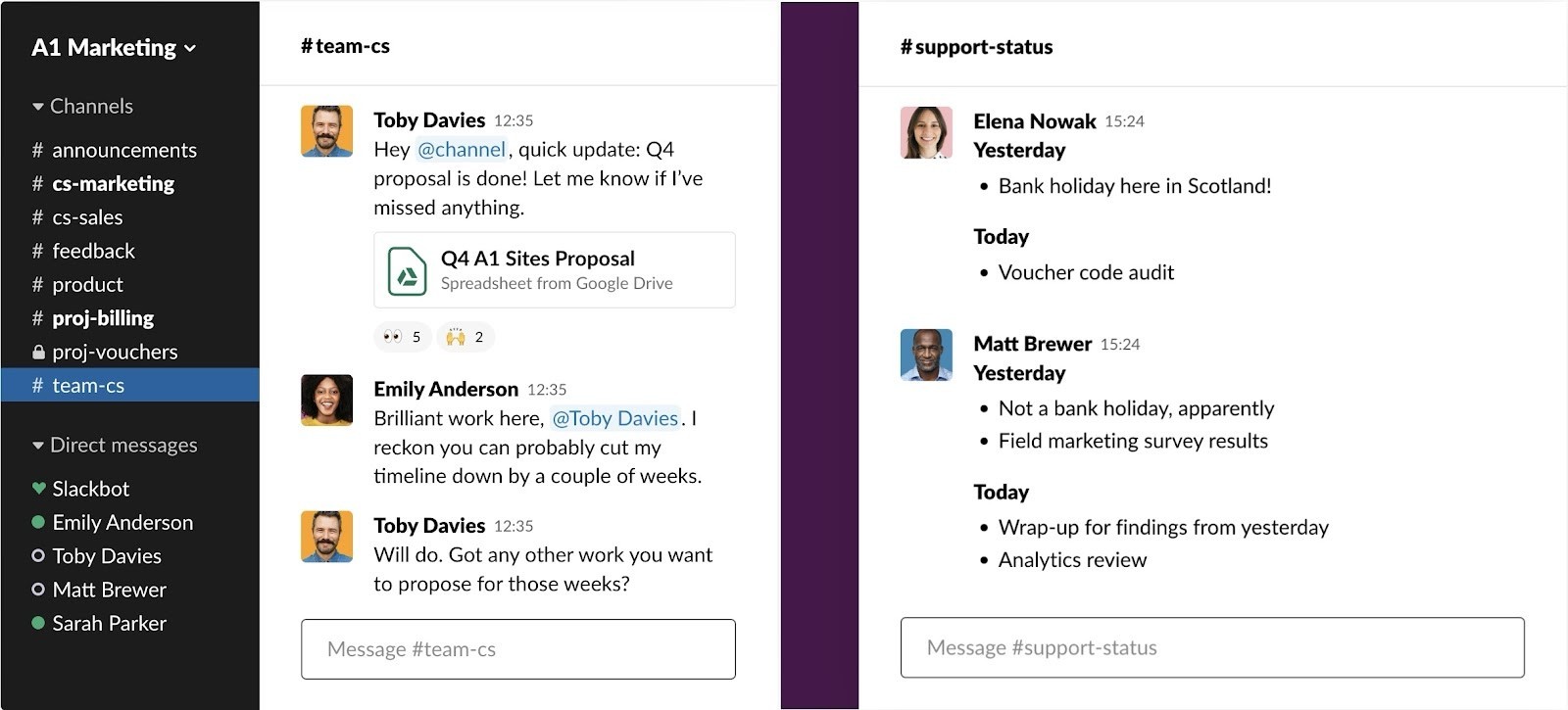
Image source: slack.com
Slack is a communication platform that combines instant messaging and integrations. It streamlines workflows and promotes efficient communication within organizations and across external partners.
Key features of Slack:
Direct messaging: Send private messages to individuals or small groups.
Channels: Organize discussions by teams, tasks, or projects for better focus and collaboration.
Slack connect: Collaborate securely with external partners through shared channels.
Huddles: Start instant audio or video calls directly within the platform.
Search functionality: Easily locate messages, files, or conversations.
Pros:
Multilingual support enhances accessibility for global teams.
An intuitive and user-friendly interface simplifies navigation.
Feature-rich mobile app for seamless communication on the go.
Advanced search capabilities make finding information effortless.
Cons:
Relatively high subscription costs for premium plans.
Huddles need advanced tools like screen recording which other tools have built-in.
The free plan offers limited features and storage capacity.
Integrations:
Slack integrates with various productivity-enhancing tools, including Google Sheets, Gmail, Google Forms, Google Calendar, Notion, Airtable, Salesforce, HubSpot, and Typeform.
Rating:
4.5/5 on G2
Wrike - Best for project management
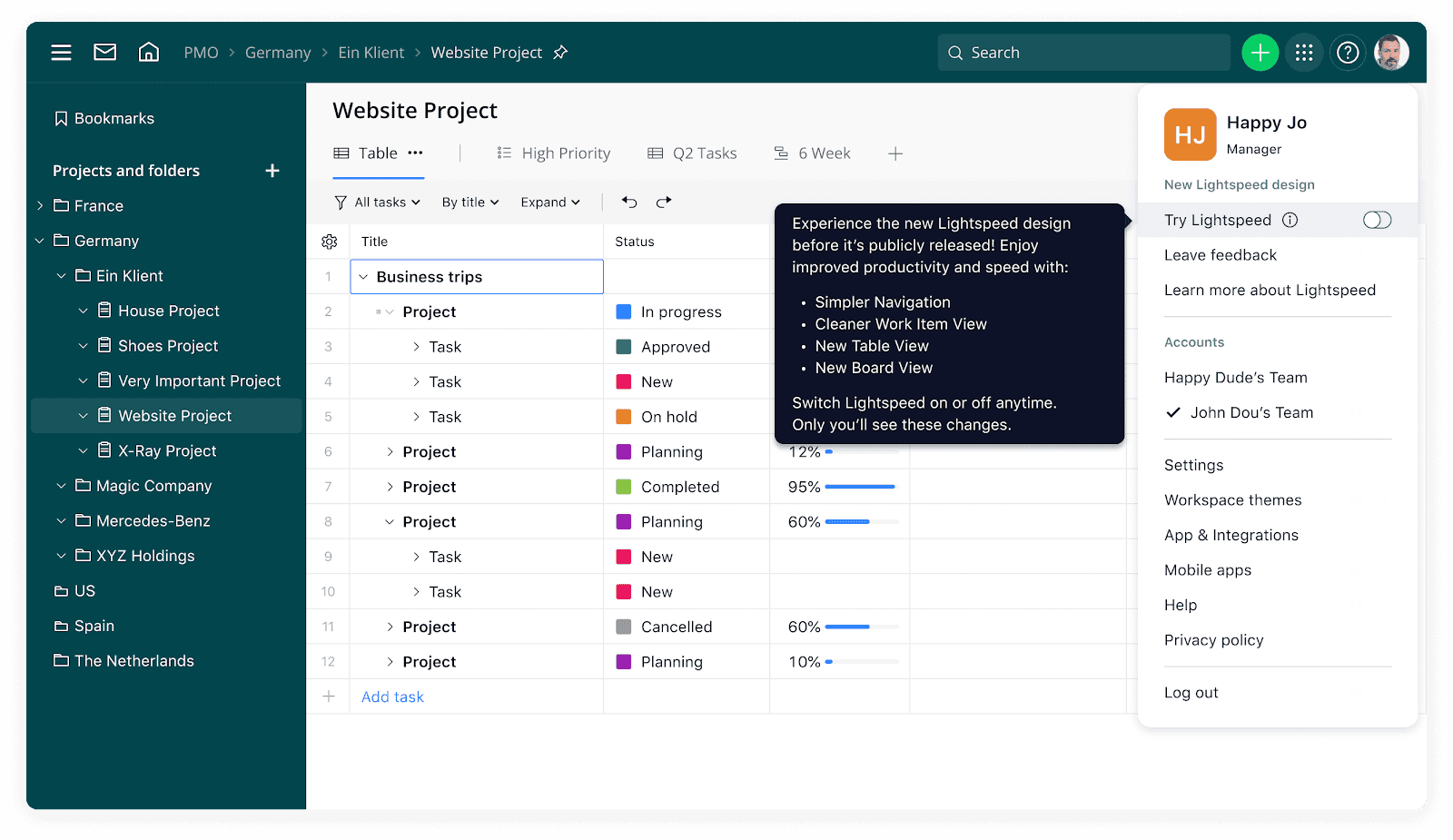
Image source: help.wrike.com
Wrike is a project management platform that simplifies task organization and team collaboration. Its robust features make it ideal for businesses of all sizes seeking to streamline workflows.
Key features of Wrike:
An intuitive three-pane interface for managing projects, tasks, and workflows in a single view.
It allows dynamic form creation with automation for task assignments and project creation.
Real-time analytics with updated performance metrics, charts, and infographics every 15 minutes.
Tags and folders simplify task organization, sharing, and resource access.
Pros:
Reporting tools enable managers to track team workloads and project progress efficiently.
Teams can customize templates to save time and streamline repetitive tasks.
Supports direct feedback on files like PDFs, videos, and documents.
It simplifies task assignments and external collaboration.
Cons:
Lacks a feature for quickly jotting down and retrieving notes.
Unlike Lark, advanced features are limited to costly premium plans.
Some app integrations delay notifications, reducing real-time responsiveness.
The default task filter hides completed tasks, requiring manual adjustments.
Lacks an internal chat feature, relying on third-party tools for communication.
Integrations:
Wrike integrates with tools like QuickBooks, Power BI, Google Drive, Zoom, Miro, and more to enhance functionality.
Rating:
4.2/5 on G2
Asana - Best for task and workflow automation
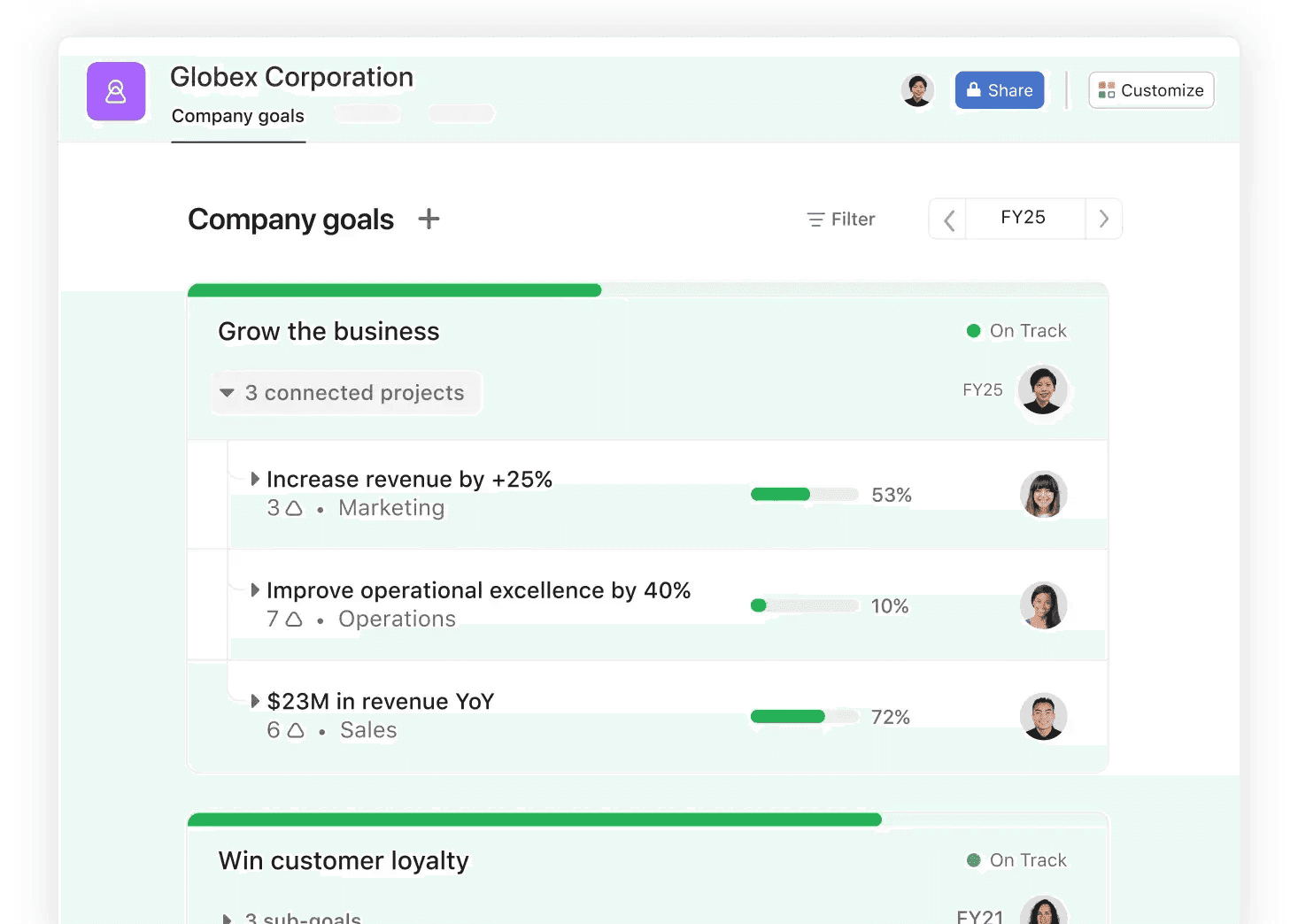
Image source: asana.com
Asana is a cloud-based task management solution that helps businesses streamline project organization, collaboration, and communication.
Key features of Asana:
Manage projects end-to-end with clear roles and deadlines.
Break work into manageable tasks with owners and due dates.
Visualize work through lists, timelines, Gantt charts, or Kanban boards.
Add labels to tasks for sorting, filtering, and reporting.
Pros:
Offers intuitive design and personalization options like color-coded projects.
Allows teams to prioritize and organize tasks efficiently.
Promotes transparency, real-time communication, and accountability.
Cons:
Beginners may find the interface complex without proper onboarding.
Tasks can only be assigned to one person, restricting flexibility.
Extensive features may overwhelm users who are handling more straightforward projects.
There may be better alternatives for task management.
Integrations:
Asana integrates with tools like Microsoft Teams, Zoom, Mailchimp, Slack, and over 150 others to extend its functionality.
Rating:
4.4/5 on G2
ClickUp - Best for customizable workspaces
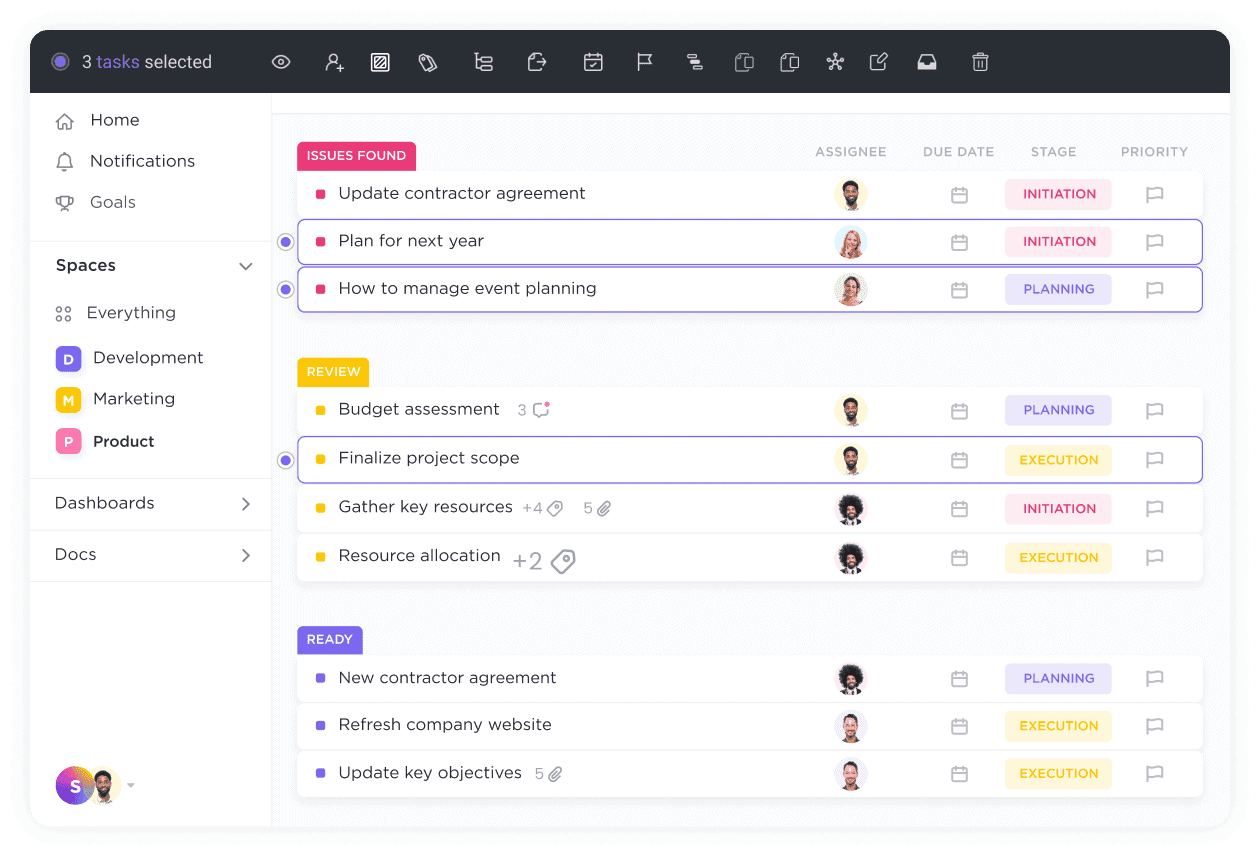
Image source: thedigitalprojectmanager.com
ClickUp is a project management tool for streamlining work processes. Its customizable features make it a popular choice for individuals and organizations.
Key features of ClickUp:
A centralized hub for all tasks and projects.
Organize work by departments or teams with customizable settings.
Break down projects into smaller, manageable segments.
Enable teamwork with shared tasks, real-time communication, and file sharing.
Visualize project progress through real-time charts and customizable insights.
Pros:
ClickUp allows users to tailor workflows, dashboards, and labels for improved efficiency.
Its clean dashboard simplifies task management and tracking.
Features like comments, mentions, and task assignments boost teamwork.
Built-in tools help monitor productivity and billable hours.
Cons:
Its many features can overwhelm new users.
The integration options are fewer than some competitors offer.
The tiered plans can be confusing and lead to unnecessary costs.
The platform may feel cluttered for extensive teams.
The mobile app lacks some desktop features.
Similar to Lark, but less advanced.
Integrations:
ClickUp integrates with Slack, GitHub, GitLab, Webhooks, HubSpot, Everhour, Toggl, Harvest, Google Drive, OneDrive, Dropbox, Outlook, Google Calendar, Apple/Outlook Calendars, SSO, and Figma.
Rating:
4.7/5 on G2
OnlyOffice - Best for self-hosted productivity
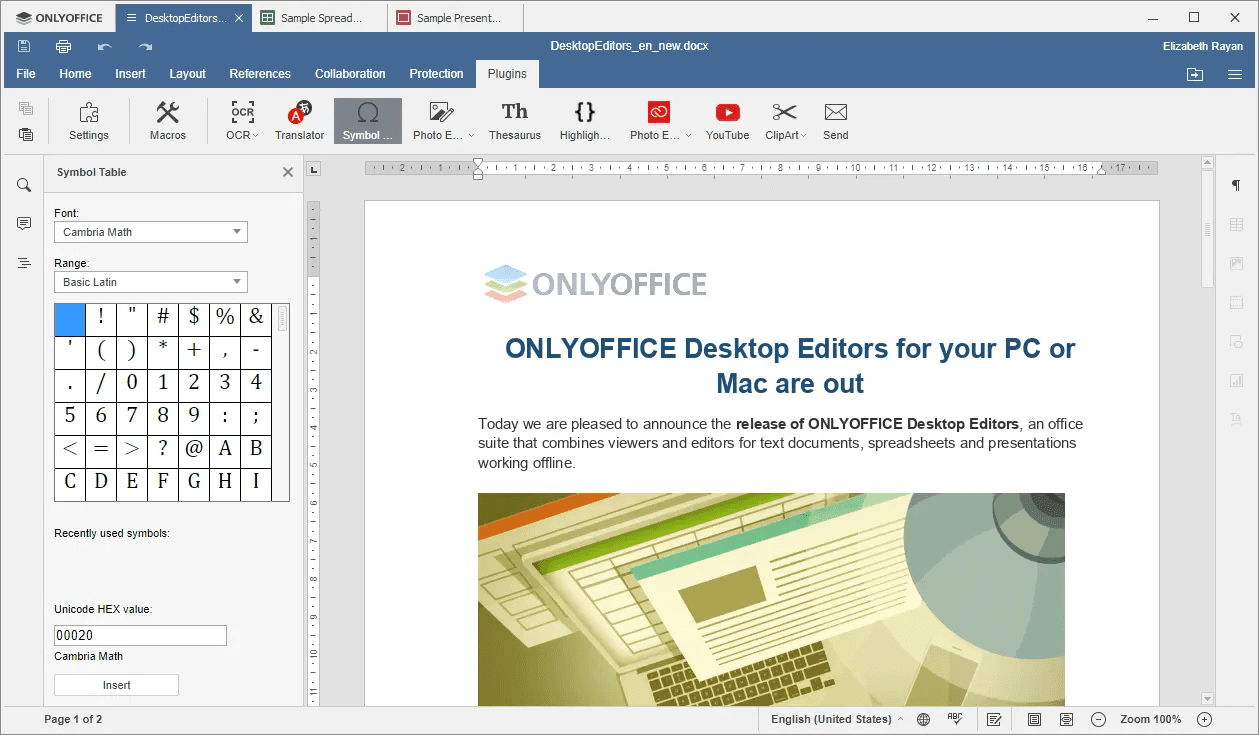
Image source: portable-linux-apps.github.io
OnlyOffice is a GDPR-compliant office suite that is open source. It offers tools for document processing, file management, projects, email, and more.
Key features of OnlyOffice:
Create fillable forms, assignments, and workbooks; share them with filling permissions; save them as PDFs.
Store materials, assess content, monitor activities, create blogs/forums, surveys, and build knowledge bases.
Available via browser, desktop, and mobile.
Customizable for students and teachers.
Suitable for small teams to large universities.
Offers educational discounts and tailored plans.
Advanced data protection and private cloud options.
Fully accessible for online classes.
Pros:
Linux support.
Microsoft Office compatibility.
Sleek dashboard and CRM integration.
Easy document editing across devices with browser-based access.
Cons:
Slow loading times.
Confusing layout and challenges when editing existing documents.
Integrations:
OnlyOffice integrates with Moodle, OpenOlat, Chamilo, WordPress, Nextcloud, Seafile, Confluence, and more.
Rating:
4.0/5 on G2
LibreOffice - Best open-source office suite
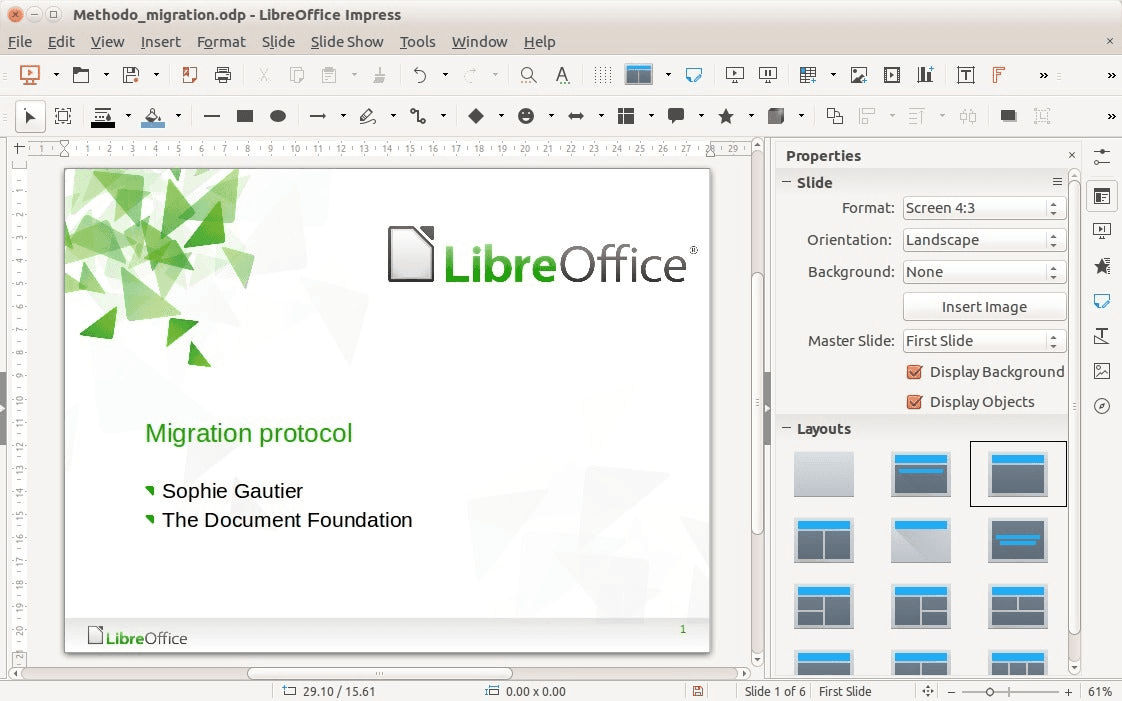
Image source: pcworld.com
LibreOffice is a free, open-source office productivity suite. It offers tools for word processing, spreadsheets, presentations, diagrams, and databases.
Key features of LibreOffice:
Exports documents in .docx format with enhanced support for Microsoft Office files.
Alternative user interface option for easier navigation.
Create e-books directly from documents.
Use OpenPGP keys to secure the signing and encryption of files.
Add custom watermarks to pages.
Multi-threading support for faster processing.
Pre-designed templates in Impress for content-focused slides.
Pros:
Free and user-friendly.
Cross-platform compatibility (Windows, macOS, Linux).
Rich features for various tasks.
Broad file format support, including Microsoft Office.
Customizable with extensions and templates.
Cons:
Interface less polished than commercial suites.
Occasional compatibility issues with complex Microsoft Office files.
Lacks dedicated customer support.
Limited advanced features compared to commercial alternatives.
Restricted integration with some software ecosystems.
Integrations:
LibreOffice integrates with Writer, Calc, Base, Liferay, OpenClipart.org, goQR.me, Zotero and Collabora Online.
Rating:
4.3/5 on G2
Monday - Best for visual project planning
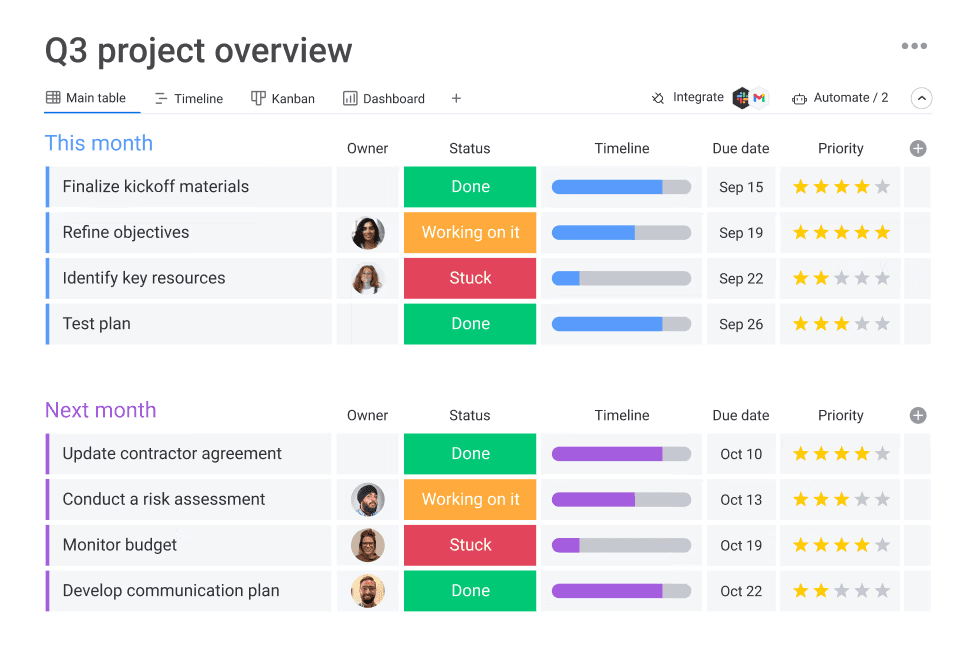
Image source: monday.com
Monday.com is a flexible platform that helps teams manage projects and tasks and collaborate. It offers tools for tracking work, organizing resources, and managing sales and support. Simple to use and customizable, it is suitable for businesses of all sizes.
Key features of Monday:
Task creation and assignment with prioritization
Drag and drop functionality for easy workflow management
Multiple views (Calendar, Kanban, Timeline, etc.)
Automation for repetitive tasks
Pros:
User-friendly interface with customizable templates.
Extensive integrations to centralize workflows.
Free plan available for small teams.
Cons:
Pricing can be expensive for larger teams.
Advanced features are limited to higher-tier plans.
Limited reporting and analytics tools.
The mobile app lacks full desktop functionality.
Integrations:
Over 200 integrations, including Slack, Gmail, and Microsoft Teams.
Rating:
4.7/5 on G2
How to choose the right Google Workspace alternative
Finding the right alternative requires careful consideration of your team’s unique needs. Here’s a step-by-step guide to help you make the best choice:
Assess your team’s needs
Identify essential features like document collaboration, video conferencing, email, and cloud storage.
Consider workflow requirements—do you need real-time editing, advanced permissions, or automation tools?
Evaluate collaboration & communication tools
Ensure the platform supports seamless team collaboration with chat, video calls, and file sharing.
Look for integrations with third-party apps your team already uses.
Check flexibility & scalability
Choose a solution that adapts to your business growth and changing needs.
Look for customizable workflows, storage options, and user roles.
Compare costs & value
Weigh the pricing plans against the features provided—cheaper isn’t always better if key functions are missing.
Consider free alternatives or lower-cost solutions that still meet your requirements.
Prioritize security & compliance
Ensure the Google alternative follows industry security standards, including encryption and data protection.
FAQs about Google Workspace alternatives
Is there a free alternative to Google Workspace?
Yes, free alternatives include LibreOffice and Lark. They can effectively meet the needs of individuals, small teams, or businesses operating on a limited budget.
While LibreOffice has limited features, Lark has extensive features that are completely free for small to medium-sized teams.
What’s the best alternative to Google Workspace for small businesses?
Lark and Zoho Workplace are the best alternatives for small businesses. Both offer affordability and essential tools like email, file storage, and document editing. If you’re looking for project management software and collaboration tools all rolled into one, we recommend you try Lark. In addition, while Dropbox Business is not among the best options listed, it remains a solid choice for small, agile teams.
What are the best Google Workspace alternatives for email?
Zoho Workspace, Microsoft, and Lark are the top alternatives for email, providing end-to-end encryption and privacy-focused features.
Final thoughts
Choosing the right alternative to Google Workspace can be challenging, but Lark emerges as the standout option. Its powerful all-in-one app offers robust communication tools, seamless workflow automation, advanced data management, and real-time collaboration features, making it an ideal choice for organizations of all sizes.
Lark not only simplifies operations and boosts productivity but also ensures top-notch security, comparable to enterprise-grade solutions. Whether your priority is pricing, security, or feature set, Lark delivers it all by combining messaging, video conferencing, file sharing, and document collaboration in one platform. As a free Google Workspace alternative, it’s an excellent solution for businesses looking to enhance team efficiency and drive growth at an affordable price. Give Lark a try and experience the transformation in your workflow.
Table of Contents







